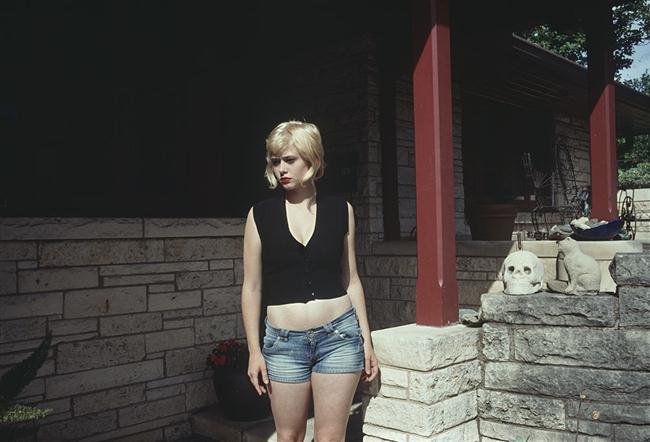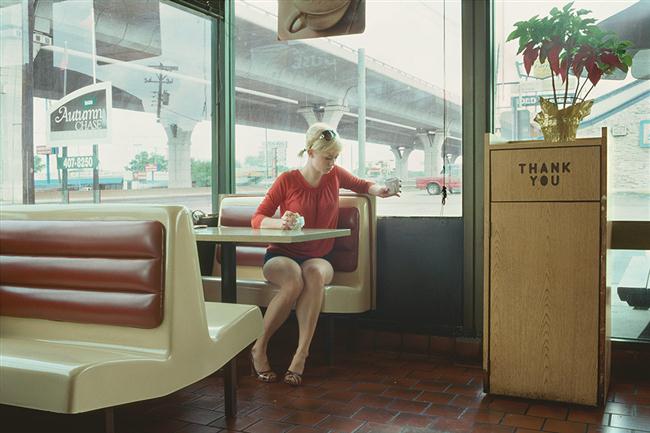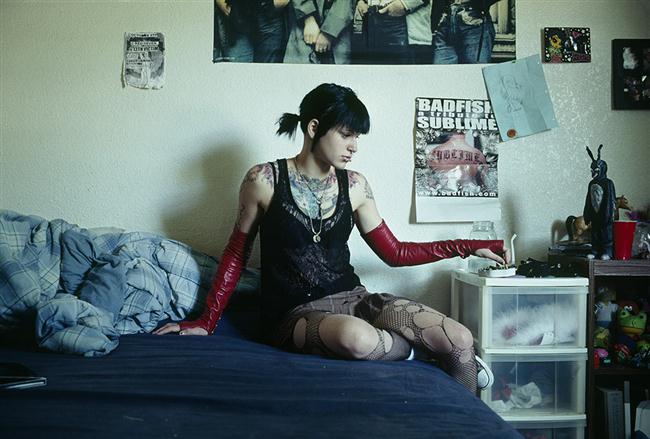“For me, the feeling of my body in space is really important. It’s all very simple there. Everything seems more real, more authentic, and you can project yourself more easily.”
Lise Sarfati and Rick Owens, Austin, Texas. Fashion Magazine 2008
What could they talk about, Rick Owens, a Californian who’s lived in France for years, and Lise Sarfati, a French woman who travels around the U.S.? About fabrics, shapes and the teenage experience, about pastry and eccentricity. At Owens’ Paris workshop, on the terrace until the rain chased them indoors, Lise and Rick sketched out together the moving contours of a first meeting.
Lise Sarfati: My big idea for this Fashion Magazine was to play off the interior and exterior, the home of each of the girls photographed and its environment. From the bed to the yard, so to speak. The series at the beginning of the book starts with this girl Sasha who left her Texas hometown to live in a California forest with the Rainbow Family.
Rick Owens: The Rainbow Family ? Are they multiracial ?
Lise Sarfati: No. It’s just a collective of people who’ve decided to live free from the chains of money, off the grid, like nomads or outlaws. I thought they’d be hippies, but once I got there I noticed that they had all these dogs, that they deliberately lived like barbarians in some ways. They never washed and all they did all day was smoke dope. That was their way of life, like a tribal community.
Rick Owens: How did you convince them to let you take their picture ?
Lise Sarfati: I’d met Sasha two years before in Austin, Texas, when she was living in a very lovely house. A few months ago, before going back to Austin, I called her mother, who told me that Sasha had left for California. Immediately I had an idea for how this Fashion Magazine would start. I’d begin the series with Sasha in the woods – and that, in turn, would take me back to Austin. See, Sasha rejects everything – consumer society, America, its way of life and its clothes.
Rick Owens: What a nice romantic story. This was about a boy, wasn’t it ?
Lise Sarfati: Yeah. She was in love, and after that her body changed. She became very thin, very tall, almost androgynous. I wanted to photograph other commune members (some of them, I found out, were hiding out in the woods because they were wanted – I don’t really know by who, the police I imagine). But when I got there, Sasha was all I was interested in. And here’s Jennifer, another girl I photographed in front of the house she lives in most of the time, in Austin. What about you, Rick – where are you from ?
“A lot of things fascinate me: the simplicity of the elements involved, the beauty of the houses. I love the wooden homes of the middle class.”
Rick Owens: From Porterville, inland between Los Angeles and San Francisco. A town that looked a lot like what you photographed in Austin. My parents’ house was almost like Jennifer’s, except that it was stucco and not brick. The details were the same: white and green, with window frames and a glass door. Our house was built in the 1940s; it had high ceilings because it was once a presbytery. The similarities go even further: I went to a school that one of these photos reminds me of, and my mother looked like the mothers in your book… How did you find all these girls ?
Lise Sarfati: At their schools. Or through acquaintances. For instance, Rosemary was a friend of Sasha’s, who also introduced me to three or four of her other buddies. This is Eva Claire. I met her two years ago when I was working on The New Life series in Austin. As for Jennifer, she’s the girlfriend of an old friend.
Rick Owens: And you, where did you grow up ?
Lise Sarfati: In Nice, in the south of France, near the border with Italy. A city where most people you meet are either elderly or teenagers. The kids were pretty wild. They loved getting into fights with the Italian fascists, and these confrontations took place downtown, which was like a no-man’s land, very close to the border and designed by Italian architects. A lot of artists lived in Nice too, like Ben, who started the Fluxus movement, and many Russians who came there after the 1917 revolution. Some funny mixes.
Rick Owens: By comparison, when you go to Austin, do you find it exotic ?
Lise Sarfati: No. I like going to small towns where the people get bored. At first it was hard to unfold a story around that, using a human being, a body, an environment, a house.
Rick Owens: It would have been easy to do the same thing in Nice. Why did you go all the way to Texas ?
Lise Sarfati: I lived in Russia for ten years before going to the States in 2003. I didn’t want to stay in Nice ; that would have been absurd. Although it doesn’t matter where I am since I’m always where I want to be. It’s all a question of what you want.
Rick Owens: You seem to be attracted to the American Midwest. What do you like about the U.S. ?
Lise Sarfati: The space. For me, the feeling of my body in space is really important. It’s all very simple there. Everything seems more real, more authentic, and you can project yourself more easily.
Rick Owens: I’m trying to get an idea of what would be interesting to someone like you, who comes from Nice…
Lise Sarfati: But I didn’t go straight to Austin from Nice !
Rick Owens: Okay, someone from Europe. I was trying to figure out what, as an American, I have in common with you, why you would be interested in a city like Austin that doesn’t fascinate me at all. As a European, what attracts you about it ?
Lise Sarfati: A lot of things fascinate me: the simplicity of the elements involved, the beauty of the houses. I love the wooden homes of the middle class. Two trips ago, while I was there shooting ads, I had a lot of contact with rich people, who lived in rich people’s homes. It was really boring. But I really like Jennifer’s house, which looks a little like where you grew up. It has a history and a real style. The homes of the well off have no depth; they’re too new, so new it’s almost frightening. Everything about them is functional; there’s no aesthetic touch. What about you, did you feel the same thing? Did you go into voluntary exile in Paris to change your world?
“I’ve been to quite a few big cities: Portland, Oregon ; New Orleans ; Los Angeles ; San Francisco. And I’ve noticed that in the smaller cities, towns that to me seem to be a sort of “second America,” it’s much easier to talk to people.”
Rick Owens: Sometimes people ask me if I miss LA. I never think about it. I know I’ll go back one day, even if I haven’t set foot there for six years. There are so many other places to go. Anyway, what I do I can do anywhere. Why Paris? It’s not even because I love this town, it’s just more practical for me. I’m not very sentimental. I think I could live anywhere, as long as I can buy something to eat.
Lise Sarfati: Isn’t that a pose? For an American, it’s so elegant to live in Paris.
Rick Owens: I don’t know. What I do know is that my situation is slightly perverse and I love it – someone like me living in the heart of the seventh arrondissement! It’s funny; that makes me happy. But on the other hand, since I don’t speak French, I’m very comfortable with being a foreigner. Paris is a very beautiful, and, to my eyes, terribly exotic city.
Lise Sarfati: Does that disjunct energize your work in a new way ?
Rick Owens: I think it leads me to be more open to artifice than in the past, even though I’ve always been a great admirer of that form of European refinement.
Lise Sarfati: By “artifice,” do you mean more sophisticated ?
Rick Owens: That in particular. Take the example of pastry. In Austin, all they have is doughnuts. In Paris, downstairs from where I live, there’s a whole window-full of incredible sweets – a layer of this, a layer of that and then another layer on top of that. It’s more than sophistication. It’s overdeveloped, exaggerated and extreme. Decadent, in a sense, because it’s absolutely unnecessary. That must have had some influence on my design work.
Lise Sarfati: Why the word “decadent” ?
Rick Owens: Because French culture has to survive, but it doesn’t have time. And since most people are running around all the time, they focus on these little cakes, putting on a layer of cream in one place and a layer of whipped cream in another. When a culture has had the time, the money and the peace required, it has invented elaborate things.
Lise Sarfati: But we French people feel that France is losing its personality under the influence of the American economy and its ideology. When I was a teenager, I used to get taken to a store where a shoemaker made the shoes himself, right in the back. They were made of all kinds of different materials put together, like something out of a Fellini movie. Soft leather boots with dark red laces. Today all that’s gone: you can’t find things like that anymore.
Rick Owens: Do you know why ? Because the Europeans were sick of all that artifice. And people like you turned to America in a quest for authenticity, for things made in a more humble and honest fashion.
Lise Sarfati: It’s true that I love the simplicity of the surroundings, the small towns with their main streets lined with wooden houses. But as someone who speaks so well of simplicity, how closely do you look at people?
Rick Owens: Not very. I don’t think I’m very discerning when it comes to people; I never look at them closely.
“But we French people feel that France is losing its personality under the influence of the American economy and its ideology.”
Lise Sarfati: You don’t look them in the eye? You don’t need to do that ?
Rick Owens: In a way. It’s funny that you should say that, since people have thrown that in my face before : “You don’t need anyone !” There’s something true about that: I’m very inner-directed, very selfish, living in my own little world. Michelle, the woman I live with on and off, often tells me that I’m not very giving. Since I grew up in pretty self-indulgent environment, sometimes I say to myself, “What will happen to me when I’m seventy years old? Will I become a monster ?” But I have to stay concentrated on myself to remain creative. My work isn’t focused on the decorative. It’s about volumes, shapes and textures. And even more important, the fibers themselves, the weave of the cloth, which allows me to go further in my designs.
Lise Sarfati: Are you an existentialist designer ?
Rick Owens: Is that existentialist ?
Lise Sarfati: Yes, the idea of going deeply inside things.
Rick Owens: That sounds good. You’re right… Inside, as much as possible.
Lise Sarfati: I asked Azzedine Alaïa the same kind of question: what’s your idea of clothing design?
Rick Owens: For Monsieur Alaïa, who’s someone I deeply respect, everything is organized around the construction. My sensibility isn’t very different: I love putting things together, working on a body and making three-dimensional clothing. I never went to fashion school – I studied pattern-cutting instead. I went to technical school so I could get a job, and I learned to make patterns. I did that for six years in various Los Angeles shops. That was my training in how to make clothes. I don’t know if many other couturiers know how to make something out of a piece of cloth all by themselves.
Lise Sarfati: Besides LA, what are your favorite American “second-tier” cities ?
Rick Owens: I’m not particularly attracted to small cities in the U.S. I grew up in Porterville, California, one among a multitude of towns, including one perched high up in the mountains. The students who lived up there came down in a bus. It took two hours in winter, because of the snow, and some days they were stuck up there in the clouds. It was very glamorous. They were all athletic, tall and good-looking, always tan from skiing. There seemed to be something special and exotic about them. As if they belonged to a different species. The mountains were a marvelous place to go, because the kids there were very free. And Sasha, the young woman who lives in the California woods, makes me think of them.
Lise Sarfati: I’ve been to quite a few big cities: Portland, Oregon ; New Orleans ; Los Angeles ; San Francisco. And I’ve noticed that in the smaller cities, towns that to me seem to be a sort of “second America,” it’s much easier to talk to people. Especially teenagers. What interests me about American teenagers isn’t the social dimension. It’s adolescence from a more general point of view, as a metaphor, a transition, a mirror. It’s a time when you feel unstable, not really a part of the world around you. You feel like you’re somewhere else, never where you should be.
Rick Owens: I really like the idea of adolescence. There’s also something sad about it. Because these kids who are so full of fears and idealism, and who feel so determined, will inevitably have to come to terms with the world, sooner or later, as we all have done. That’s how I see the teenage years, as sweet, sad, energized and sexual. Even though I have no patience with teenagers, I still feel like one myself, in a way, because I really loved that time in my life, maybe too much, and I have to be able to get over it. Some day.
ASX CHANNEL: Lise Sarfati
For more of American Suburb X, become a fan on Facebook and follow ASX on Twitter.
For inquiries, please contact American Suburb X at: info@americansuburbx.com.
All images © copyright the photographer and/or publisher




